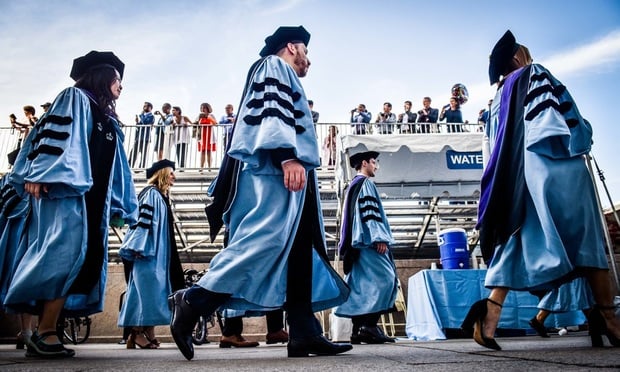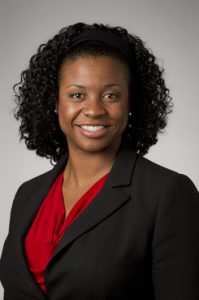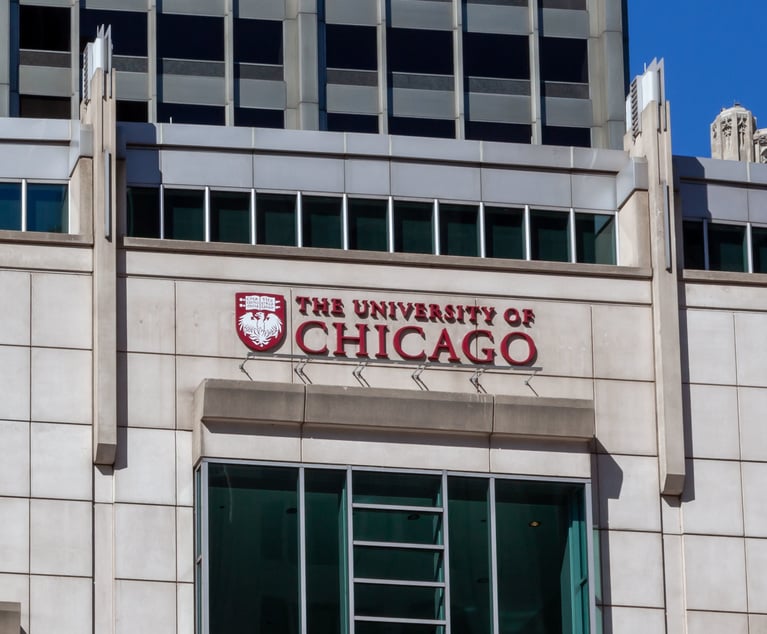And No. 1 on This Year's Go-To Law Schools Is …?
Columbia Law School tops the Go-To Law School's list for the sixth straight year. sending a higher percentage of 2018 graduates to Big Law than any other campus. Meanwhile, the University of Pennsylvania Law School moved up to the No. 2 slot.
March 07, 2019 at 07:00 PM
9 minute read
 Graduating law students march into commencement at Columbia Law graduation in May 2018. Photo by David Handschuh
Graduating law students march into commencement at Columbia Law graduation in May 2018. Photo by David Handschuh
Columbia Law School remains at the top of the Big Law heap.
The New York institution sent a higher percentage of 2018 graduates into associate positions at large firms than any other law school, landing it in the No. 1 spot on Law.com's Go-To Law Schools ranking for the sixth straight year and cementing its well-established reputation as a key Big Law feeder.
Among Columbia's most recent graduating class, 71 percent are now working as associates at the nation's largest 100 law firms. That's up from 68 percent the previous year and is 11 percentage points higher than the No. 2 school on our list, the University of Pennsylvania Law School.
Register here to snag a spot in a live discussion on March 14 between Law.com legal education reporter Karen Sloan and Law.com editor-in-chief Leigh Jones about this year's Go-To Law Schools Report.
Penn moved up three spots this year with 60 percent of its 2018 graduates heading to large firms. Northwestern University Pritzker School of Law moved up two slots to No. 4, while Cornell Law School picked up three spots to claim No. 6 this year. Much of the rest of the top 10 held steady, with New York University School of Law retaining its No. 3 position and Duke Law School and Harvard Law School remaining at Nos. 7 and 8, respectively. The University of Virginia School of Law fell one spot to No. 5.
Visit the full 2019 Go-To Law Schools report here to see our top 50 ranking according to the percentage of recent graduates hired by Big Law; the campuses that saw the most alumni promoted to partner last year; and the schools that outperform their U.S. News & World Report rank when it comes to large firm hiring.
The biggest change among the top schools was perennial No. 2, the University of Chicago Law School, which dropped seven spots to No. 9 this year, a decline the school attributed to a higher number of students landing clerkships rather than going straight to large firms.
Columbia's success in the Big Law hiring market is a combination of factors, including the intense preparation students undergo in the run-up to on-campus interviews and the school's location in the nation's biggest legal market, said Dean of Career Services Marta Ricardo.
“We look at every single resume. We make every single student do a practice interview with an external lawyer. We prepare them as much as possible,” Ricardo said. “They also have the benefit of having spent their first year of law school in New York City. They see all the leading practitioners come to campus. They are very prepared, in terms of what Big Law practice looks like.”
Additionally, prospective law students who aspire to work at large firms are particularly attracted to Columbia because of its strong track record of sending graduates on that career path, she added.
Nationwide, law schools enjoyed a strong year on the Big Law hiring front. Among the 50 law schools most popular with large firms, more than 30 percent of all 2018 graduates landed associate jobs at the largest 100 firms, which is up from 29 percent the previous year. That increase is due both to a modest rise in the number of those Big Law associate jobs—4,336 new graduates were in those positions—as well as a slightly smaller pool of 2018 law graduates.
The uptick in the number of new associate positions last fall indicates that large firms aren't curtailing their entry-level attorney hiring as a result of starting salaries jumping from $160,000 to $180,000 in many offices. (The 2018 graduating class was the first to go through the summer associate recruiting process after starting salaries at many major firms increased in 2016. Some firms have since raised salaries further, to $190,000.)
The National Association for Law Placement reported that the 2016 summer associate recruiting season, which was the point at which students in the class of 2018 got their foot in the door of Big Law, was “as competitive and fast–paced as ever,” and that the race for entry-level talent was particularly fierce in the New York market. Even so, the amount of hiring at large firms remained relatively stable, as our data also found.
Each year, Law.com asks the largest 100 law firms, determined by The National Law Journal's annual lawyer head count survey, to tell us how many new associates they hired and from which law schools those new associates graduated. We then rank the top 50 schools based on the percentage of their juris doctor graduates who were hired by those firms, highlighting Big Law's primary feeder schools. We also query firms on the law school alma maters of their latest crop of new partners. Nearly all firms supplied those figures. For those that did not, we relied on data from ALM's Rival Edge database and independent reporting to determine their new associate data.
The Go-To Law Schools ranking does not purport to show which schools have the strongest overall employment outcomes. It doesn't capture graduates who take jobs at prestigious boutique firms, for instance. Nor does it include 2018 juris doctors who are currently in clerkships, which are some of the most sought-after entry-level positions. (Our ranking also excludes 2018 LL.M. graduates hired by the largest 100 firms last year.)
A rise in clerkships is a major factor in Chicago's seven-spot decline in this year's Go-To Law School ranking, said Lois Casaleggi , the school's senior director of career services. Twenty-seven percent of graduates from the class of 2018 are currently clerking, which represents a 6 percent increase over the previous year. (The vast majority of the school's clerks go on to associate positions at large firms, she added.) Moreover, Chicago saw a small increase in the percentage of 2018 graduates who took corporate and business positions, further decreasing the number going straight into Big Law.
Chicago is also one of the smallest of the elite schools, meaning aggregate employment statistics can change significantly based on the choices of relatively few students. “Each student of ours is basically half a percentage point. You get a couple students who go do something in a different category and that makes things look a little different year to year,” she said.
The American Bar Association won't release official law school employment data for the class of 2018 until the spring, but 2017 data shows that a handful of highly ranked law campuses dominate the federal clerkship scene. Yale Law School, which ranks No. 22 on this year's Go-To Law Schools list, sent nearly 30 percent of its 2017 graduates into federal clerkships. It was followed by Stanford Law School at 26 percent; Chicago at 21 percent; Duke at 17 percent; and Harvard at 16 percent.
The robust employment market for 2018 grads extended beyond the elite law schools. The University of Houston Law Center, ranked No. 56 by U.S. News & World Report, saw one of the biggest climbs on the Go-To Law Schools list. It moved from No. 43 last year to No. 29 this year, an increase of 14 positions. More than 16 percent of the most recent graduating class are now Big Law associates, which represents the second-highest among law schools in the Lone Star State, behind only the University of Texas School of Law.
 Tiffany Tucker.
Tiffany Tucker.Tiffany Tucker, assistant dean for career development at the University of Houston Law Center, chalked up part of the school's recent employment success to the hot legal market in Houston.
“We've seen an increase, in general, of large firms coming into the Houston market,” she said. “There are so many more firms coming into the area that there are just more opportunities for students.”
Additionally, the school in recent years made its professionalism program for first-year students mandatory, meaning they each attend four to six professionalism training sessions before they begin the law firm hiring process. That has paid dividends, Tucker said.
“We have been getting so much wonderful feedback from employers that our students are above the rest on professionalism,” she said.
Many career services officials say they are cautiously optimistic about the upcoming summer associate recruiting cycle, which will kick off this summer. Large firms in general have been posting record profits, which schools hope will fuel continued demand for summer associates, and later, first-year associates. But they also are closely watching the national economic picture for any signs of a potential slowdown that could ripple through the legal market. Moreover, they are trying to gauge whether major changes to NALP's entry-level recruiting guidelines this year will disrupt the status quo.
“I think we need to plan for the hiring and [on-campus interviews] in 2019 to be similar to hiring in 2018,” said David Diamond, assistant dean for career strategy and advancement at Northwestern. “It could be up slightly. We never know what's going to happen with the economy. That could lead to everything being exactly the same, or even retracting a little. I don't expect there to be a massive increasing in hiring, though.”
This content has been archived. It is available through our partners, LexisNexis® and Bloomberg Law.
To view this content, please continue to their sites.
Not a Lexis Subscriber?
Subscribe Now
Not a Bloomberg Law Subscriber?
Subscribe Now
NOT FOR REPRINT
© 2025 ALM Global, LLC, All Rights Reserved. Request academic re-use from www.copyright.com. All other uses, submit a request to [email protected]. For more information visit Asset & Logo Licensing.
You Might Like
View All
University of Chicago Accused of Evicting Student for Attending Gaza-Israel Protest
3 minute read
Sanctioned Penn Law Professor Amy Wax Sues University, Alleging Discrimination
5 minute read

The Met Hires GC of Elite University as Next Legal Chief
Trending Stories
- 1How ‘Bilateral Tapping’ Can Help with Stress and Anxiety
- 2How Law Firms Can Make Business Services a Performance Champion
- 3'Digital Mindset': Hogan Lovells' New Global Managing Partner for Digitalization
- 4Silk Road Founder Ross Ulbricht Has New York Sentence Pardoned by Trump
- 5Settlement Allows Spouses of U.S. Citizens to Reopen Removal Proceedings
Who Got The Work
J. Brugh Lower of Gibbons has entered an appearance for industrial equipment supplier Devco Corporation in a pending trademark infringement lawsuit. The suit, accusing the defendant of selling knock-off Graco products, was filed Dec. 18 in New Jersey District Court by Rivkin Radler on behalf of Graco Inc. and Graco Minnesota. The case, assigned to U.S. District Judge Zahid N. Quraishi, is 3:24-cv-11294, Graco Inc. et al v. Devco Corporation.
Who Got The Work
Rebecca Maller-Stein and Kent A. Yalowitz of Arnold & Porter Kaye Scholer have entered their appearances for Hanaco Venture Capital and its executives, Lior Prosor and David Frankel, in a pending securities lawsuit. The action, filed on Dec. 24 in New York Southern District Court by Zell, Aron & Co. on behalf of Goldeneye Advisors, accuses the defendants of negligently and fraudulently managing the plaintiff's $1 million investment. The case, assigned to U.S. District Judge Vernon S. Broderick, is 1:24-cv-09918, Goldeneye Advisors, LLC v. Hanaco Venture Capital, Ltd. et al.
Who Got The Work
Attorneys from A&O Shearman has stepped in as defense counsel for Toronto-Dominion Bank and other defendants in a pending securities class action. The suit, filed Dec. 11 in New York Southern District Court by Bleichmar Fonti & Auld, accuses the defendants of concealing the bank's 'pervasive' deficiencies in regards to its compliance with the Bank Secrecy Act and the quality of its anti-money laundering controls. The case, assigned to U.S. District Judge Arun Subramanian, is 1:24-cv-09445, Gonzalez v. The Toronto-Dominion Bank et al.
Who Got The Work
Crown Castle International, a Pennsylvania company providing shared communications infrastructure, has turned to Luke D. Wolf of Gordon Rees Scully Mansukhani to fend off a pending breach-of-contract lawsuit. The court action, filed Nov. 25 in Michigan Eastern District Court by Hooper Hathaway PC on behalf of The Town Residences LLC, accuses Crown Castle of failing to transfer approximately $30,000 in utility payments from T-Mobile in breach of a roof-top lease and assignment agreement. The case, assigned to U.S. District Judge Susan K. Declercq, is 2:24-cv-13131, The Town Residences LLC v. T-Mobile US, Inc. et al.
Who Got The Work
Wilfred P. Coronato and Daniel M. Schwartz of McCarter & English have stepped in as defense counsel to Electrolux Home Products Inc. in a pending product liability lawsuit. The court action, filed Nov. 26 in New York Eastern District Court by Poulos Lopiccolo PC and Nagel Rice LLP on behalf of David Stern, alleges that the defendant's refrigerators’ drawers and shelving repeatedly break and fall apart within months after purchase. The case, assigned to U.S. District Judge Joan M. Azrack, is 2:24-cv-08204, Stern v. Electrolux Home Products, Inc.
Featured Firms
Law Offices of Gary Martin Hays & Associates, P.C.
(470) 294-1674
Law Offices of Mark E. Salomone
(857) 444-6468
Smith & Hassler
(713) 739-1250








